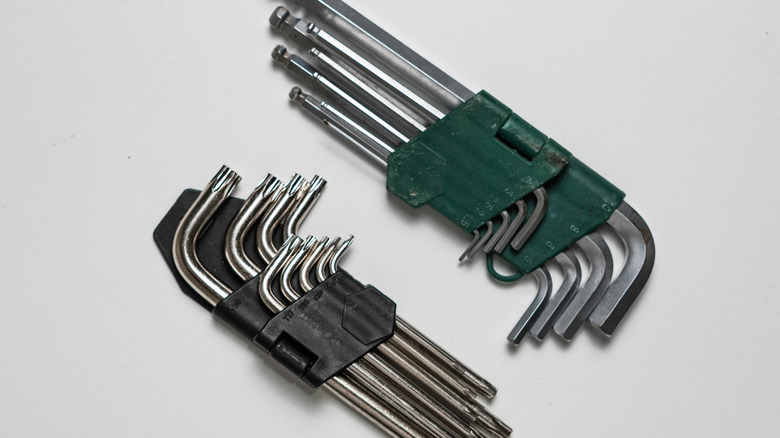Hex Key Vs. Allen Wrench: Is There A Difference?
Because of its small size, high torque strength, and recessed installation, the hex socket screw is a great alternative to regular bolts. The main tool used to tighten or loosen hex socket screws is called a hex key, which has a hexagonal recess in the head. Hex keys are normally used in bicycle maintenance, furniture, and construction and look very similar and are sometimes called Allen wrenches. Hex keys and Allen wrenches are basically the same, with the name Allen coming from the company that manufactures the tool.
An Allen wrench and hex key reference an identical L-shaped tool with a hexagonal tip used for screws or bolts. The origins of the tool go back to 1910, when Allen Manufacturing patented the first hexagonal head tool. Toolmakers since the mid-19th century have been developing safer and cheaper alternatives to screw and square-type fasteners. Allen Manufacturing was the first to create a successful version, and, despite a slow start, its use adoption grew to the level it is today, where its considered a vital tool, making it a good addition to a home tool kit.
In 1964, another inventor named John Bondhus made an important innovation to the design of the Allen wrench when he created the Balldriver. Also called a ball driver Allen wrench, it features a rounded, ball-shaped end that enables it to be used at an angle, making it ideal for use in recessed or hard-to-reach areas when tightening or loosening screws. Later on, a further refinement to the Balldriver called the Magic Ring was created by tool company Wiha by adding a rubber ring to the ball end that helps hold the fastener.
Small and highly versatile tools
Modern hex keys or Allen wrenches are normally made of different kinds of metals, the most common being chrome vanadium steel, chrome molybdenum, aluminum, carbon steel, or even titanium. In addition, these tools come in diverse finishes like chrome, nickel, and burnished. There are three main types of Allen wrenches, including the common L-shaped, which is often used for bicycles and furniture; the T-handle, for automotive repairs and maintenance; and the ball-end, for specialized applications. Lastly, Allen wrenches come in several sizes, ranging from 0.7 mm up to 10 mm.
When using an Allen wrench, it is crucial to consider the screw or bolt's size, the wrench's material, and the end type that is required. Choosing the right kind guarantees the right fit and better grip making it easy to work the screw or bolt, and avoids damaging the wrench and screw by stripping or wearing it out. While its ideal to always use an Allen wrench for hex screws and similar fasteners, there is an alternative when you don't have an Allen wrench that could be used as a temporary implement for urgent needs.
As with any tool, knowing the proper way of using Allen wrenches, using PPE, and proper storage are important practices that contribute to personal safety and tool longevity. Since its inception by William Allen over a hundred years ago, the applications for the Allen wrench have evolved from its industrial revolution origins. Today, the Allen wrench is used for simple household DIY projects, electronics, machinery manufacturing, and assembly lines, proving its value and versatility, which contributes to its continuing popularity.

